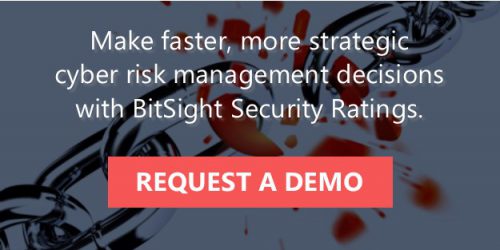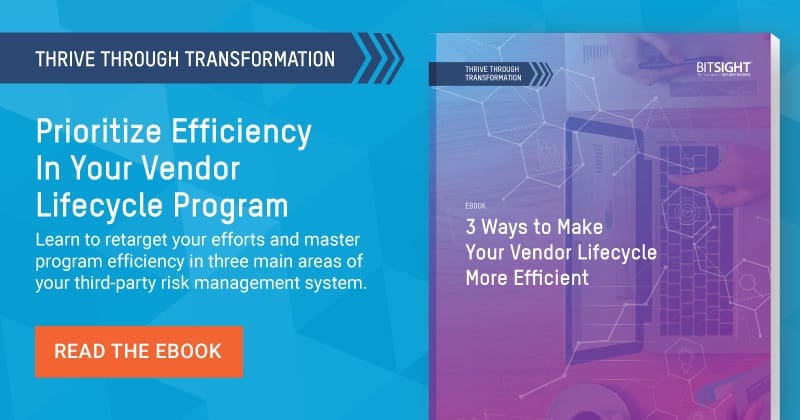During this dynamic and stressful workplace environment 2020 has brought us, finding the most efficient ways to perform in your job has never been more important. When it comes to managing your vendor lifecycle, there are three ways you can implement more efficient processes to save time and money for your business.
Staying competitive with your peers can be difficult as budgets are being re-evaluated, but when you can capitalize on efficient processes with the resources you already have you can maintain a solid standing in your industry.
One area company leaders might overlook, but security teams know can have a huge impact on operational efficiency across the organization, is your vendor lifecycle management. Managing outside vendors effectively can place you ahead of your peers, but finding which areas of vendor lifecycle management you can improve on is difficult with competing priorities.
Focusing on the critical onboarding phase, your reassessment process, and the way you communicate your risk summaries to the board are three areas where you can start.
1. Set onboarding policies that enable you to work with the best vendors
It is crucial to find efficient onboarding policies during your vendor onboarding stage to ensure that you are working with the most secure third-parties. Having a stable and readily followed onboarding processes with policies that are supported across the business will also present your company as a reliable organization to partner with, and will help you attract the best vendors in the industry.
Here are three areas you can optimize your policies to ensure efficiency in this area of your TPRM program:
- Setting a minimum requirement for security measures your third-parties have to hit before they can be onboarded into your internal systems efficiently narrows down your daunting list of vendors. BitSight for Third-Party Risk Management provides third-party security ratings to help decide between vendors in a fraction of the time.
- In our current climate of primarily remote workforces, ensuring quick communication and approvals can be difficult if the steps were not previously mapped out prior to the COVID-19 pandemic. Procurement, legal, and finance will all need to be involved at some point throughout the onboarding process for various approvals and contract points, so try bringing a representative from each department early during vendor assessment.
- Communicate policies and third-party decisions to all functional business unit leaders and managers. Problems arise when information isn’t clearly communicated across the board to all departments. Connecting the security team to the rest of the organization is important when securing resources from the board. Including all business units when giving updates on third-parties is a good policy for enabling the individual parts of the business to support each other.
2. Create the right (re)assessment process to scale your program efficiently
Failing to focus on efficiency throughout the entire lifecycle can end up erasing your hard work during onboarding. Promoting efficiency during the assessment stages allows for successful risk mitigation, even as your list of vendors continues to grow. Often we see security professionals relying on traditional methods when evaluating vendors, like long lists of vendor questionnaires. Maturing your vendor risk management program with a tiering structure and continuous monitoring technology will enable your organization to grow without being held back by outdated vendor management strategies.
Tiering
Security professionals know that some vendors are more important to their organization than others. Grouping these vendors in structured tiers based on the inherent risk you’re willing to accept will help focus your resources during the assessment process. BitSight for TPRM assists users with tiering vendors by setting rating requirements for different tiers. For vendors working directly with sensitive company information, stricter limits can be placed on how low their rating is allowed to drop before the user is alerted. For the less critical vendors, more flexibility is given to inherent risk. Instead of treating all your third-parties the same, tiering allows security teams to clearly see which third-parties require more frequent and in-depth assessment.
Continuous Monitoring
You can also highlight vendor lifecycle efficiency by removing the yearly schedule for assessing your third parties, and instead work under a continuous monitoring system. Continuous monitoring gives security managers full-time insight into the threats and status of their third-party ecosystem to tackle malicious activity to a vendor’s system before even being notified by the vendor themselves. BitSight’s TPRM software will notify users when a third-party experiences a sudden drop in their score, and point the security team directly to the vulnerability point. Continuous monitoring also takes security management back into the hands of the TPRM team. You don’t need to rely on your vendors being timely and forward in a security report if you have access to the data on your own account.
3. Communicate risk summaries successfully to make your program best-in-class
Security professionals can’t afford to overlook the importance of communicating with your organization’s leadership team. Generally speaking, being prepared to discuss third-party risk initiatives and positioning with your organization’s leaders will help secure cybersecurity resources. Minimizing confusion with the board with help build trust between the security leaders and the company decision makers. Here are two important factors to consider to practice efficient communication with company leaders:
Context
Many security leaders forget that the metrics and terminology they use in their day-to-day operations are not commonly used by the board, which adds a layer of difficulty and skepticism when it comes to communicating the numbers and requesting budget. It is important to also include context surrounding how the metrics relate to the overall business. Connecting the dots for how your numbers are impacting the company’s overall goals, including information about the industry averages and your company’s historical performance, and providing a high-level overview describing different malicious activities you might discuss to help when communicating with your board.
Solutions
When board members are presented with the status of how our security systems are performing, the next step is to consider what will be worked on in the future to either continue or improve what’s being done. A security professional should bring both tactical and strategic examples of team goals for the future in order to best communicate trust with the board. Tactical steps are good for board members to see a detailed, specific set of steps the security team can take to reach their program goals. Also taking a strategic approach to discussing vendor management will help the board compare your team to company competitors.
Read On To Learn More?
Download the full eBook to learn about how to make your vendor lifecycle management more efficient, as well as to discover what third-party risk management resources BitSight and DVV Solutions have to help you along the way. Please download the guide for vendor lifecycle efficiency.
This article was originally published by BitSight and is shared with their kind permission.
Get Your Free Custom Assessment of your Third-Party Cyber Risk
 There’s never a more vital time to start thinking seriously about the security posture of your organisation and the cyber supply chain you rely on. DVV Solutions are here to help with BitSight Managed Services and Consultancy proven to improve your ability to assess, analyse and manage more Third-Party cyber and data privacy risk domains.
There’s never a more vital time to start thinking seriously about the security posture of your organisation and the cyber supply chain you rely on. DVV Solutions are here to help with BitSight Managed Services and Consultancy proven to improve your ability to assess, analyse and manage more Third-Party cyber and data privacy risk domains.
Learn how you can quickly launch, grow, or optimize a third-party risk management program with the resources you have today.
Simply Complete our Contact Form
Or for more advice and information on any Third-Party risk challenge you have call us on +44 (0) 161 476 8700

